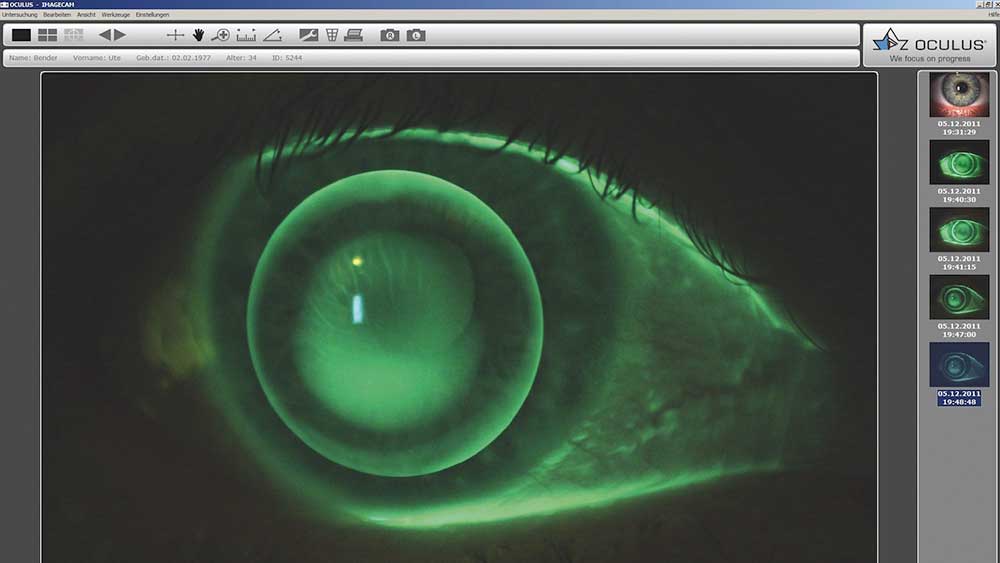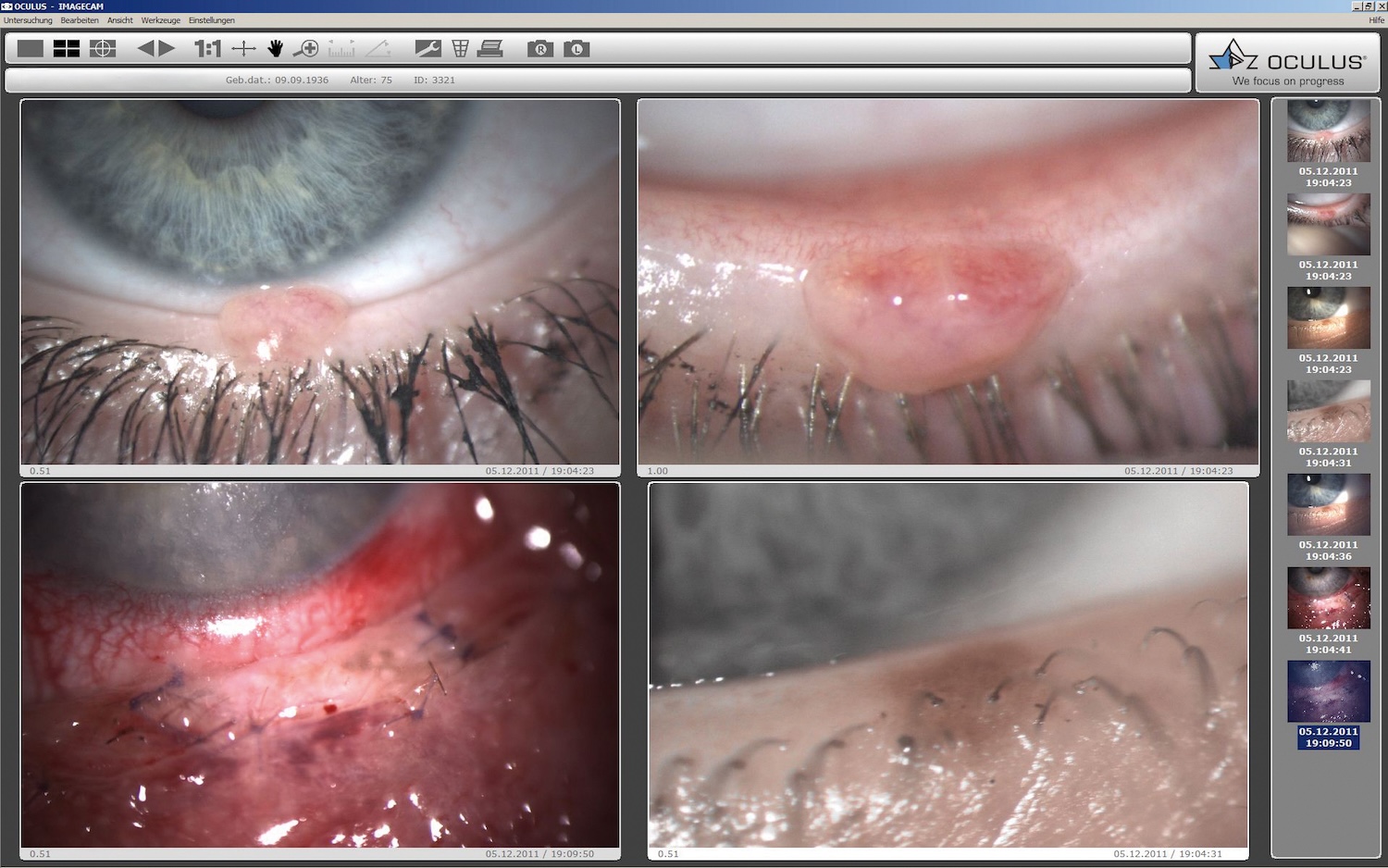
OCULUS Optikgeräte GmbH
Fluorescein image with the OCULUS ImageCam 3 visualizes the accuracy of a contact lens fit on the cornea.
The slit-lamp examination is one of the most important diagnostic techniques in ophthalmology. It enables a detailed examination of the anterior, middle, and posterior segments of the eye. Ophthalmologists can use it to recognize the smallest changes, anomalies, or damage. This procedure is used for the early detection and monitoring of eye conditions such as corneal injuries, eye infections, retinal detachment, or macular degeneration.
|
ADVERTISEMENT |
However, with its fast movements, the eye is a challenging subject to photograph; motion blur and shaking are typical image errors. To facilitate diagnostics for ophthalmologists and opticians, improve the workflow, and shorten examination times, fast and reliable slit-lamp documentation systems are required. They must provide meaningful images and be designed to be user friendly and ergonomic.

Image: OCULUS Optikgeräte
The German company OCULUS Optikgeräte develops instruments for eye diagnostics for ophthalmologists, optometrists, and opticians. Part of its extensive portfolio is one of the world’s smallest and lightest image documentation systems for slit lamps. A powerful high-resolution USB3 Vision industrial camera from IDS is integrated, making it especially suitable for applications in medical technology and microscopy.

IDS uEye CP model U3-3270CP Rev.2.2. Image: IDS.
Efficient system
The OCULUS ImageCam 3 universal slit-lamp image documentation system is not only intuitive and easy to use but also sets high standards in digital slit-lamp photography. This includes an outstanding field of view that enables highly precise diagnoses of the anterior, middle, and posterior segments of the eye. The images are captured by a particularly low-light, high-performance IDS camera from the USB3 uEye+ CP family.
“Only a fast camera delivers low-noise images in the difficult recording situations at the eye,” says Michael Moos, product manager at OCULUS. “The advanced camera features enable continuous shooting at up to 60 frames per second. Among other things, these series recordings make it possible to record the eye during breaks in movement. The innovative frame-out-of-video function enables simple documentation of the entire examination process at the slit lamp, whereby the best quality individual images can then be selected for evaluation.”
The OCULUS ImageCam 3 makes this possible without any loss of quality while minimizing the time required.

Series recordings of the OCULUS ImageCam with IDS USB3 Vision camera. Image: OCULUS Optikgeräte.
Powerful camera
The camera from the IDS CP family is predestined for use in medical technology because it offers extensive pixel preprocessing and has an internal 120 MB image memory for buffering image sequences. This enables a high data rate of 420 MB/s, low CPU load, and easy integration. The Sony Pregius IMX265 in the model used here is considered one of the best CMOS image sensors in the 3 MP class. The USB3 Vision industrial camera U3-3270CP Rev.2.2 with the 1/1.8 in. global shutter sensor achieves a resolution of 3.19 MP (2064 x 1544 px).
“In this case, however, the image is scaled down using AOI in order to achieve a significantly higher frame rate,” says Phillip Schissler, sales manager, medical and microscopy at IDS.
OCULUS has integrated the camera with the IDS peak software development kit. “IDS peak allows users to test camera functions in detail and optimize them for their own applications,” says an IDS medical expert.
However, the camera is not only recommended for medical technology and microscopy in terms of sensitivity, dynamic range, and linearity. In addition to the required light intensity and speed, the size of the camera was also a decisive selection criterion for the model. At around 50 g, the camera’s 29 mm x 29 mm x 29 mm magnesium housing is as light as it is robust, underlining its suitability for space-critical applications.

OCULUS ImageCam 3 with IDS industrial camera is adaptable to almost all slit lamps. Image: OCULUS Optikgeräte.
Facilitated slit-lamp diagnostics
To deliver optimum diagnostic images, the system includes a high-quality beam splitter in addition to the camera. A beam splitter divides the light between the camera and the eyepiece of the slit lamp to simultaneously illuminate and view the eye, allowing a detailed examination of each eye segment. The beam splitter of the OCULUS system has a purely mechanical iris diaphragm that significantly increases the depth of field, regardless of the position of the pathological findings. It can also be adapted to all commercially available slit lamps.
The camera unit and the beam splitter are extremely small and light. In daily practice, it’s barely noticeable, very easy to attach, and delivers images like no other in this size. This makes daily slit-lamp diagnostics easier.
The slit-lamp photos of the OCULUS ImageCam 3 enable objective documentation of eye conditions to monitor the progress of diseases and compare treatments. Patients also benefit from the image documentation system, which provides visual references of the diagnosis to help them better understand their state of health and the doctor’s treatment plan. Medical findings can be saved and archived accordingly.
Four-image mode—progress check. Image: OCULUS Optikgeräte.
Outlook
Innovative image processing systems such as OCULUS ImageCam—using powerful industrial cameras to deliver informative, high-contrast images with a high depth of field—help to improve diagnostic accuracy, efficiency, and patient care in ophthalmology. Artificial intelligence is increasingly being integrated into the analysis of slit-lamp images to automatically recognize diseases, support diagnostic decisions, improve workflow for doctors, and develop new treatment methods.

Add new comment